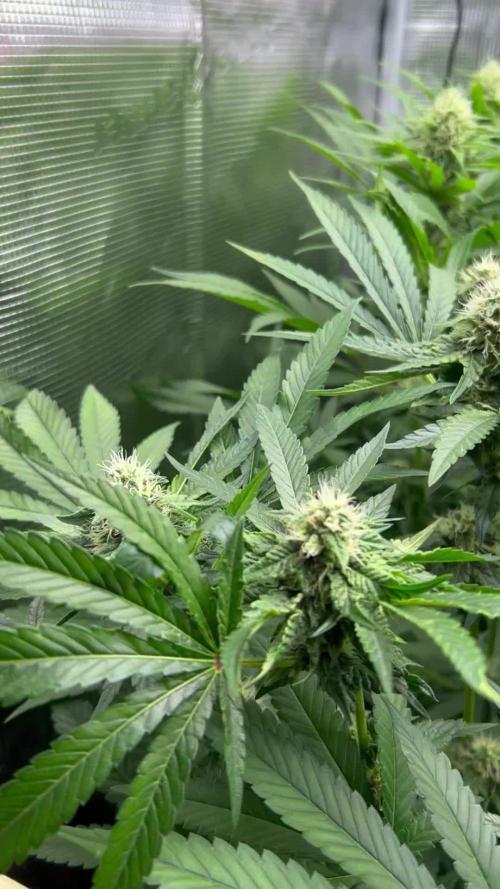The Grow Awards 2026 🏆 

































Likes
Comments
Share


@OilyEliteOrganics
Follow
Growing feet.
Reaching great height might have to back bud it .
Has some smells.
I can see the oils protruding from the leaves pores leaving a powerful aroma overall stenching up the whole pad.
Likes
23
Share


@SonomaSungrown
Follow
The plants continue to kick ass.
New French Macaron and Chem Brulee leaves are all 9-fingered now.
Crazy happy plants.
Sprayed with light BT spray (trying to avoid any caterpillar issues this year as much as possible) early in the week.
Sprayed with light Neem Oil / Castile Soap (no more dawn, no more issues!) late in the week.
Today, June 9, I also defoliated a bit.
Keep in mind that I don't want to do much this year as far as topping and training, so I've done one simple top on all of the plants, and essentially have created 4 main colas for each plant.
I only did this to create some airflow under the plant. I don't plan on doing a lot of this stuff.
Gonna let the sunshine do her thing.
Even though these girls have some hot-ass super soil in there, I'm still going to be doing some top-dressing.
Mixed this up and slathered it on there on Saturday, June 12.
------
Likes
51
Share


@homerjgangia
Follow
Sweet Seeds Runtz XL Auto
Variety: SWS88
Indica: 47,1%
Sativa: 52,5%
Ruderalis: 0,4%
THC: 17-25%
CBD: 0,5%
Interior production: 400-550 g/m²
Foreign production: 50-175 g/plant
Harvest Interior / Exterior: 8 weeks from germination
Height: 60-120 cm
Equipment:
Mars Hydro ts 1000 (veg-bloom)
Custom growbox 60x60
Biobizz nutrients (Veg & Flower)
Processing
Likes
7
Share


@STAYINGONMYMAINCBATORUNTWO
Follow
I made some extract and made some edibles and added it to the diary!
This diary may get a little unorthodox because they’re in the jungle down the centre line but will still document as much as I can and get close ups of the bud sites and buds as time goes on! Shouldn’t be too challenging but it’s a challenge lol it’s all doing great though! Better than I expected!
Likes
10
Share


@OnlyBuds
Follow
Week 6 – Fat Lemon Energy 🍋🔥
Week 6 is here and the Lamin-O-Gs are doing their thing – stacking, swelling, and smelling like straight-up citrus bombs.
Buds are thickening up, pistils are firing everywhere, and the canopy looks like it’s ready for takeoff. 🚀
💧 Feed for the week (15L):
• 20ml Topmax
• 70ml Bloom
• 50ml molasses
• 30ml EM (Effective Microorganisms)
• 30ml CalMag
The nitrogen fade is on point – older leaves are gently fading, feeding the flowers, while the tops stay lush and green. No drama, just bloom power.
These girls are soaking up every watt of light without a single complaint.
Full throttle. Lemon OG jungle vibes. 🌴
Next week? Expect even more frost and bulk – these ladies are just getting started.
Stay tuned, amigos. Only buds, no stress. 💚
Likes
4
Share


@TheNaturalist
Follow
Transplanted and topped today. I always transplant and top at the same time as new shoots equals new roots! Maximize your grow! The roots are looking amazing for this transplant. I made another coco perlite and gaia green mix. This time with a 1:2 ratio of the 4-4-4 and 2-8-4 because I will be flipping to flower the week after the plants have recovered from topping. On transplant I use a mycorrhizae powder to reduce transplant shock and aid in nutrient uptake and root development. They still need some nitrogen to support them during the stretch but the added phosphorus helps with the stretch along with potassium to setting buds. I also installed my first layer of trellis to weave the plants in early. At the end of the week I got 2 autos and wanted to see what I could do with them so I planted them and then also got rid of one of the Caramel Creams (C.C) because it was lagging behind the other one a little to much.
Likes
8
Share


@Changman
Follow
What an amazing last four weeks the ladies have packed on but out of the 10x ladies we lost only 2x GREAT SUCCESS 👍🤣
Likes
64
Share


@DogDoctorOfficial
Follow
Fast week and a lot in my life so little update for this week , sorry guys, they are growing as champions and by the end of week 5 they started preflowring, this append around day 34,35 from seed. I started a litle timelapse project an i will update on that soon , for now here just a taste of what it will be 😆💚
Girls 2# Magnum Autos from @buddhaseeds
All i grow is medicine for myself, nothing to sell
So don’t even ask 😆
💚If you put your heart in to it, you will get love out off it 💚
Growers love to you all
Likes
3
Share


@Godino
Follow
I start seeding in 17 October. 20 October all seed are germinated.The grow was so fast that i decide to start lst and topping after less 20 days( i get 5 nodes to all plants very fast ). LST will continue and i will add scrog soon! This This my first grow surprise me, the canopy grow very fast and seem thats it's all very good!!
Comments and suggestions are appreciated!
Likes
8
Share


@AERO_Grower
Follow
4° Semana- Aeroponía - Mejoría apreciable, las raíces están 100% sanas y la velocidad de crecimiento comienza a ser mayor, además el área de las hojas que realizan fotosíntesis es mayor. Se aumenta concentración de nutrientes.
---------------------------------------------------------------------------------------------------------------------------------------------------------------------------------------------------------------------
4th Week- Aeroponics - Appreciable improvement, the roots are 100% healthy and the speed of growth begins to be greater, in addition the area of the leaves that carry out photosynthesis is greater. Also increasing the concentration of nutrients.
Likes
3
Share


@I_roll_my_own_420
Follow
Here we go, 4 days before harvest time. Last 2 days, light will be off. Cant wait to cut those ladies down :)
Likes
11
Share


@jonesy_grows
Follow
Terps are definitely starting to come through, gassy and fruity. Buds directly under the light are hard as rocks.
Pistils are starting to show what kind of colas I can expect.
The back 2 plants are receiving an extra qt of hand-fertigation per day, as they dry out quicker than the front 2.
Happy growing!
Likes
39
Share


@J_diaz420
Follow
Todo marcha bien!!
Creo que lo fundamental en esta semana es arta humedad y riego foliar por encima, pero en las raíces tratar de no llenar de agua ya que a esta temprana edad la plántula no tiene tanta raíces formadas, lo que provoca que se estanquen, quedando enanas y mostrando carencias por no poder beber.
Trataré de seguir como voy, saludos 🍀
Likes
6
Share


@burnout
Follow
Day 21 of flowering more defoliation. Added 7 tablespoons of rock phosphate to each container. House is starting to smell like fruit infused gasoline despite the two carbon filters and Ona gel all over the place.
Likes
67
Share


@AwfulBuddy
Follow
Hi buddies im back to the diary
Everything is going well, the girls drink a lot 3 to 5 liters of feed per day, the Ph and EC remain stable.
I see new roots and buds continue to bloom💣 so I think they are fine and healthy.
Sensi Seeds indicates Skunk#1 with 8 weeks flowering
now i am at the beginning of week 7 bloom but I still don't see milky or amber trichomes and not even so many brown pistils, so i will repeat the week 5 feed as AN advice...
maybe from the next one I'll start with overdrive .. who knows? 😁
I made some macro videos of the trichomes, in the next few days I will update the diary with photos.
Thanks for the answers and advices to the grow questions, I know you don't do it for the free seeds, its only love 💚😜 love you too buddies
as usual thanks for stopping by and good growth everyone !!
Update: I need a tripod to take better macro shoots. Sorry for low quality pics
Likes
1
Share


@Flashdadgrows420
Follow
The overall grow was very easy and no issues! I will grow this strain again in the future! My biggest recommendation with this plant is to top it even though it’s an auto I topped it and I did lst! Both were needed to get the results that I got with floraflex! If you know it’s gonna be a tall strain based off the breeder info and you know the genetics are good then top it and lst!!!
Likes
8
Share


@Pifferson
Follow
This week was fun, had nutrient lockout on the one plant some signs on others.
Decided to flush from the top with two plants which is a terrible idea with autopots; the minerals build up in the soil and all I did was wash them down.
The plant that was looking the worse had some lower branches die after this so I cut them out.
Reached out to autopot and they were a huge help, flushed from the Rez and then brought my nutrients way down. I only just got an ec meter but I was at 3200 ppm when I started the flush and 150 by the time I added nutrients back in.
The two plants that I flushed from the top aren’t in great shape but they’re still alive, only 2 more weeks to go so hopefully this didn’t have too much of an impact on quality!



























